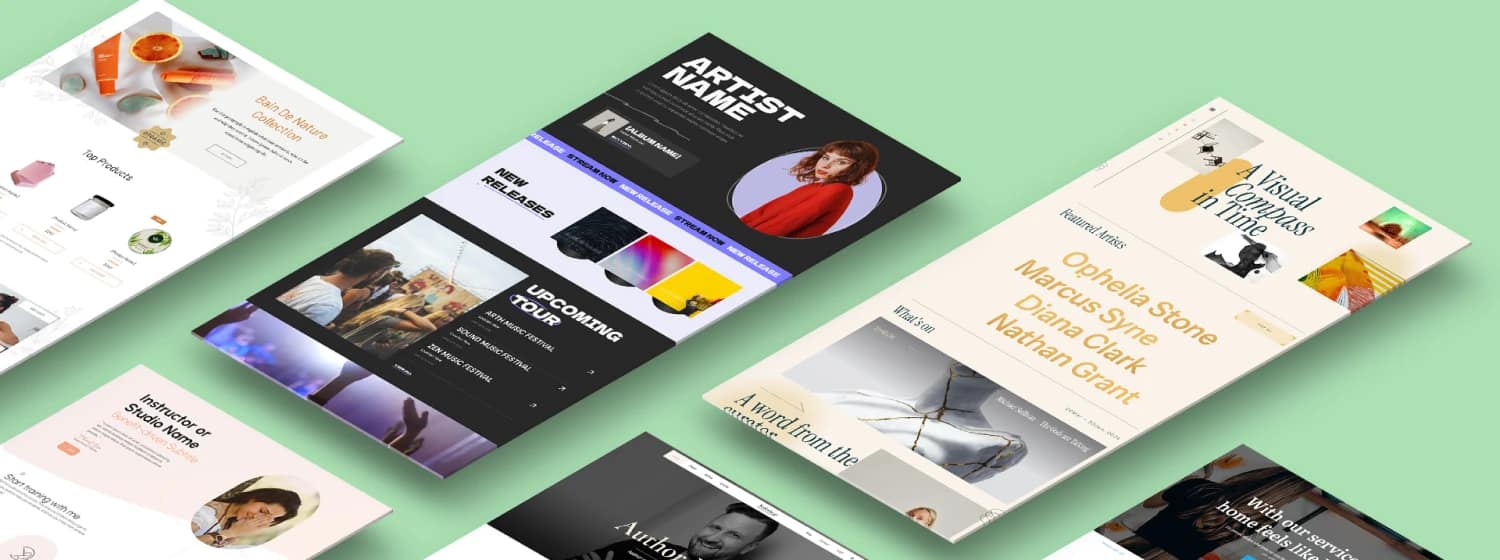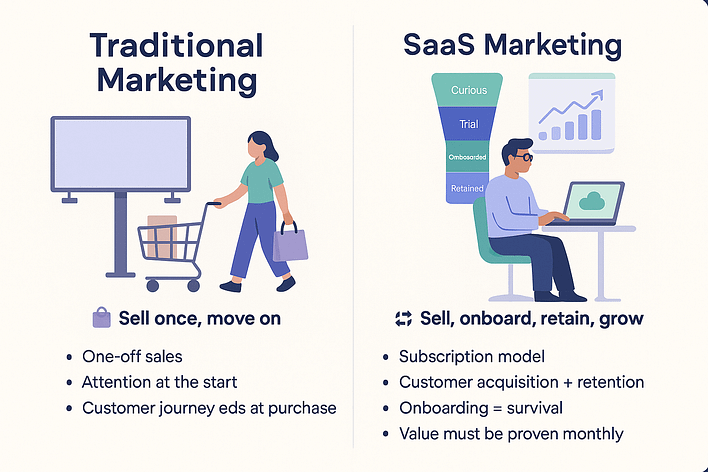If your SaaS marketing still runs on “write more blog posts” and “send another weekly newsletter,” take a breather. You must be tired.
Because let’s be real: the rules have changed.
Organic reach is collapsing. Everyone’s inbox is overflowing. And AI? It’s generating funnels in 3.2 seconds (most of them terrible).
I’ve worked in SaaS for as long as I can remember. First as a freelance writer creating blog content for startups, then helping aspiring founders build their first funnels from scratch, and now here at Thrive — working with a team that lives and breathes subscription marketing every day.
And let me tell you: the scene has changed.
You’re not just trying to “get more traffic” anymore. You’re trying to hold everything together:
Keep SaaS customer acquisition consistent
Reduce churn before it eats your growth
Build a system that doesn’t crumble with every launch
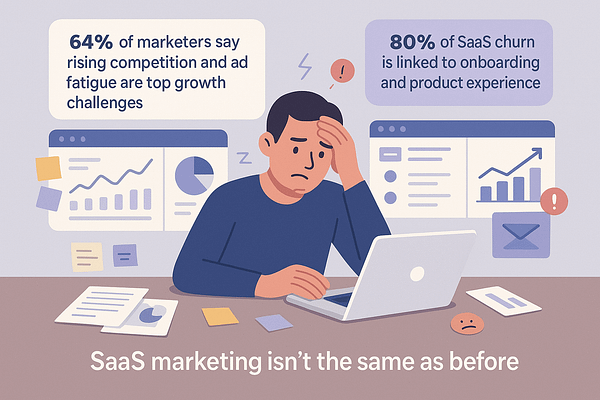
And it’s harder now for a reason. In a recent study, 64% of marketers said that increasing competition and declining ad performance are their top growth challenges (Source: HubSpot, 2024). And in SaaS specifically, product experience and onboarding now directly influence churn in 80% of companies (Source: ProfitWell, 2023).
That means your emails, landing pages, and onboarding flows don’t just “support” growth — they are growth.
So no, it’s not in your head. It really is harder now. But it’s also the best time to do things differently — with smarter funnels, tighter messaging, and tools that actually support the way people buy today.
That’s what this guide is for. To help you:
Rethink your funnel
Sharpen your message
Build a smarter, more sustainable system for SaaS growth
Let’s make it work. For real this time.
But First… Build on the Right Foundation
Before we get into the fun stuff, I need to be blunt:Most SaaS marketing funnels don’t fail because of the strategy. They fail because the website can’t support the strategy.
I’ve been there. Spending hours drafting emails, designing opt-ins, and setting up offers… only to realize my site was quietly turning users away. The traffic was coming in, but the conversions? Barely a trickle.
That’s when I started using Thrive Suite, and everything changed.
This isn’t just a stack of tools. It’s a builder’s toolkit for people who want to take real control of their SaaS funnel — without relying on developers or duct-taping plugins together.
Why I Recommend Thrive Suite (Every Single Time):
I could finally create focused, high-converting landing pages using Thrive Architect — the kind that support real SaaS landing page optimization, not just look good on desktop.
I built smart lead generation flows with Thrive Leads, tailored to different audience segments and behavior — no more generic forms.
And with Thrive Apprentice, I created onboarding spaces that actually reduced churn — because we both know that good SaaS onboarding strategies start before support tickets roll in.
But here’s what I loved most: I didn’t have to wait weeks to test a change. I didn’t need to know code. I just built, optimized, and moved faster — and the results followed.
If your SaaS marketing funnel isn’t converting the way it should, start here. Before you worry about content or campaigns or channel strategy — check the foundation.
Because once your site is truly built to convert, everything else works better.
10 SaaS Marketing Strategies That Actually Convert
Conversion isn’t a tactic. It’s a habit. These 10 strategies help you build it into every stage — from planning to testing.
If there’s one thing I’ve learned about SaaS marketing strategies, it’s that they’re only as strong as the systems behind them.It goes beyond traffic. And clicks. And email open rates.
It’s about building momentum — the kind that moves a user from “I’m curious” to “I’m in.”From free trial to fully subscribed.From monthly churn risk to long-term advocate.
In the next section, I’m breaking down the exact SaaS growth strategies I’ve used (and seen work again and again) to improve lead generation for SaaS, boost customer acquisition, and make every piece of your subscription marketing engine more effective.
Each strategy plays a role in the bigger picture — whether you're refining your offer, tightening your messaging, or testing a new funnel from scratch.
Let’s dive in.
Planning & Strategy
Before you touch a landing page or draft a subject line, you need a strategy that makes sense for how SaaS actually works. These first two steps lay the groundwork for everything that follows — from how you acquire users to how you keep them engaged. Strong planning means fewer surprises (and fewer leaky funnels later).
1. Use Product-Led Growth — But Don’t Skip the Funnel
Product-led growth (PLG) is when your product does the selling for you. Instead of relying on demos, calls, or pushy onboarding flows, you let users sign up, try it out, and experience the value firsthand — before they ever pay a cent.
I love this model for SaaS, especially for self-serve products — tools like Calendly, Canva, or Notion, where users can sign up, explore on their own, and start seeing value without ever talking to sales. It lowers the barrier to entry, builds trust quickly, and can dramatically improve SaaS customer acquisition — if you guide users intentionally.
The mistake I see too often? People assume the product will “speak for itself.” But without structure, even the best software gets ignored or abandoned.
Here’s what’s worked for me:
Step 1: Start with the right entry point
Whether it’s a free trial, freemium tier, or limited access plan — make it crystal clear what users are getting. Keep your signup form friction-free: one field, no hoops. I use Thrive Architect + Thrive Leads to build this step fast and make it feel seamless. (Need more guidance on creating the best opt-in forms? Check out this guide.)
Step 2: Map your activation milestones
What does success look like in week one? Set triggers based on usage: logging in, adding a team member, publishing something — whatever “value” looks like in your product. This gives you direction for automation.
Step 3: Set up behavioral nudges
Use a tool like Uncanny Automator to fire off onboarding emails, in-app tooltips, or upgrade prompts as users hit (or don’t hit) key actions. This is where you start turning trial users into paying subscribers — what we call trial-to-paid conversion.
Step 4: Always connect actions to outcomes
This is the part most PLG funnels miss. Every action your user takes should lead somewhere — a next step, a deeper benefit, a reason to keep going. That’s the difference between a “try before you buy” model and an actual SaaS marketing funnel.

For example, if a user completes their first action — like uploading a file, publishing a design, or connecting an integration — what’s the next logical step? Maybe it’s inviting a teammate, unlocking a bonus feature, or getting a personalized result. If you’re using something like Notion, that could look like prompting users to collaborate after setting up their workspace. You're not pushing — you're guiding.
Checklist: 5 Signs Your Product-Led Growth Funnel Has Gaps
Not sure if your PLG funnel is doing its job? Run through this list:
- Your free trial users drop off before day 3 → If they’re not seeing value early, they’re not sticking around. You might need to simplify onboarding or surface quick wins faster.
- You’re getting signups, but no upgrades → Time to audit your upgrade prompts. Are you waiting too long? Are they tied to actual behavior?
- You’re still relying on generic email sequences → If every user gets the same 7-day drip, you’re missing key personalization opportunities. Use behavior-based triggers instead.
- There’s no “aha” moment mapped out → If you don’t know what activation looks like, neither do your users. Define clear usage milestones and guide people toward them.
- You’re assuming the product will sell itself → Even great tools need direction. Your job is to create structure, timing, and prompts that help users connect the dots.
🛠️ Pro tip: Use Thrive Leads to capture intent at signup, and Uncanny Automator to trigger the right follow-ups — when they matter most.
2. Align Sales and Marketing With Shared Funnel Goals
This might sound obvious, but in SaaS, it’s painfully common: marketing brings in the leads… and sales is left guessing what to do with them.
I’ve seen the disconnect too many times — two teams chasing different goals, using different data, and wondering why the funnel isn’t converting. For a SaaS marketing funnel to work, marketing and sales need to share a clear definition of what a qualified lead looks like — and how that lead should move from “curious” to “ready to buy.”
That kind of alignment starts with what you ask upfront.
Instead of throwing users into a long, boring form, I use Thrive Quiz Builder to capture key info in a way that actually feels engaging. It’s better for the user and gives me richer data without hurting conversions.
Want to know their role, use case, or team size?
Need to qualify by pain point or budget range?
Wrap it in a short quiz and guide them to a segmented follow-up path. It’s faster, less intimidating, and gives sales a much clearer picture of what kind of lead they’re working with. And I have the perfect tutorial to help you set up an engaging online quiz funnel in WordPress.
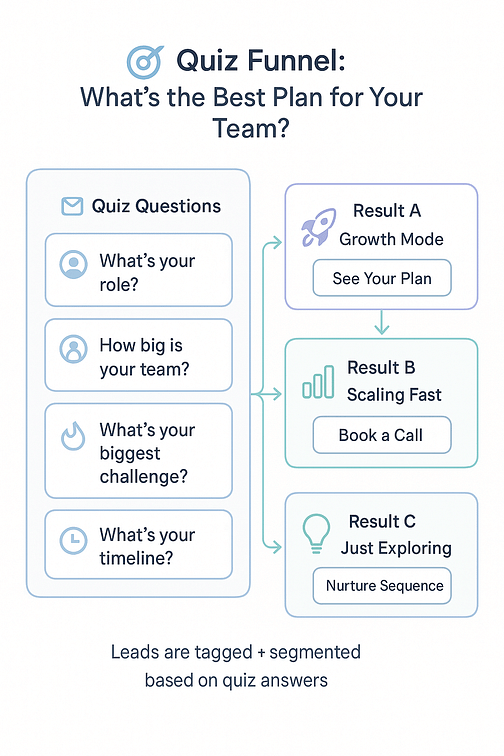
If you’re not ready for a quiz setup, you can also use Thrive Leads or Thrive Architect forms with dropdowns or multi-step fields. Either way, that data gets passed straight into my email marketing tool, where I segment based on answers, behaviors, and entry points.
The result? A smoother handoff. Better timing. And messaging that actually feels like a warm, personalized journey — not a cold sales pitch dropped out of nowhere.
If you want to improve lead generation for SaaS, don’t just focus on quantity. Focus on context — and give your sales team what they need to close with confidence.
Setup & Foundation
Once your strategy is clear, this is where it starts to get real.
Because without a solid foundation — your site, your onboarding flow, your pricing structure — all that planning goes out the window. These next steps are about building the parts of your funnel that quietly do the heavy lifting: guiding new users, earning trust, and nudging people toward the right decision without overwhelming them.
Think of it as the infrastructure for everything that follows. It’s not the flashiest part of SaaS marketing, but it’s where a lot of brands either start converting… or start losing people.
Ready to tighten up your SaaS landing page optimization, improve your onboarding strategy, and set your subscription marketing up to scale? This is where you do it.
3. Optimize Your Website for Conversion, Not Just Design
A polished SaaS site is nice. But a high-converting one? That’s the actual goal.
I used to think they were the same thing — that clean design, great visuals, and a “modern feel” would naturally lead to more signups. But the truth is, I’ve seen plenty of gorgeous sites that don’t convert. And plenty of simple, focused ones that absolutely crush it.
What I’ve learned is this: conversion comes from clarity, not cleverness.
Your website layout, messaging, and flow should make it brain-dead simple for someone to understand what you offer, why it matters to them, and how to take the next step. If your site can’t do that, even the best ads or email sequences won’t save you.
This is where SaaS landing page optimization becomes a serious advantage.
With Thrive Architect, I can build pages that are pretty and purposeful. Every element on the page has a job:
✅ Headlines that speak directly to pain points (no jargon, no fluff)
✅ Benefit-first feature blocks that actually show what someone can do with the product
✅ CTAs that feel natural, not pushy — and show up exactly when users are ready to act
✅ Layouts that are mobile-first, because if your page doesn’t convert on a phone, it doesn’t convert
Then comes the best part: testing it all.
With Thrive Optimize, I can run A/B tests without needing a developer or external tool. I’ve tested things like:
CTA button colors and placement
Headline tone (straightforward vs. playful)
Testimonial formats (video vs. quote snippets)
And what I love most is the peace of mind: I’m not guessing. I’m measuring. And when something works better, I know exactly why.
Optimizing your site isn’t just about squeezing out a few extra signups — it’s about building real momentum.
Better pages = more leads. More leads = better targeting. Better targeting = higher SaaS customer acquisition and retention rates. It all compounds.
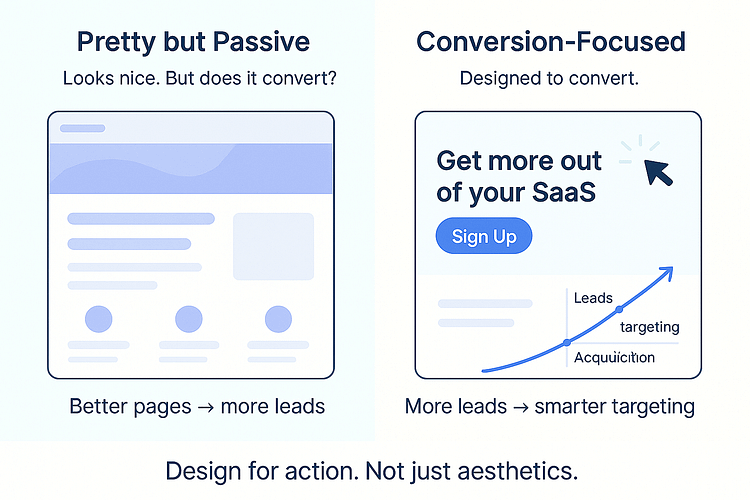
So no — looks aren’t enough. Design for action. Test for performance. Build pages that do more than impress — build pages that convert.
That’s how you turn a nice site into a growth engine.
4. Build a Value-Based Pricing Page That Sells
🗣️🗣️🗣️ Hear me and hear me well here: Your pricing page isn’t just a list of numbers — it’s a sales conversation.
And if I’m being honest, this is one of the most neglected parts of most marketing funnels – especially SaaS marketing funnels. People treat it like a table they have to check off before launch: toss in a few plans, slap a CTA underneath, and hope the user figures it out.
But when done right? Your pricing page becomes the moment a curious lead turns into a committed customer.
I think of it like this: someone reaching your pricing page has already leaned in. They’ve seen the offer. They’re wondering “Okay, but is this really for me?”
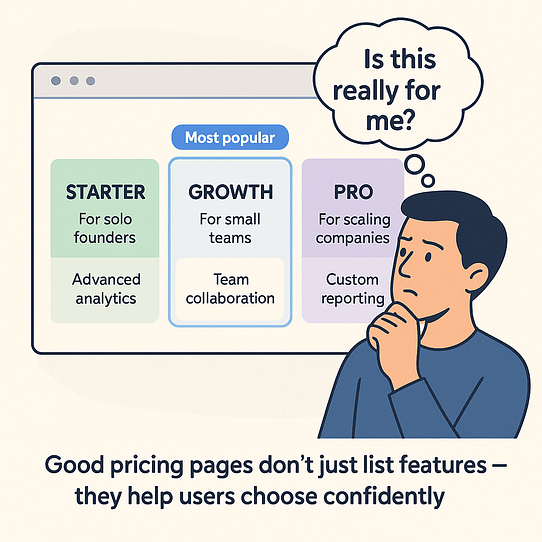
This is where value-based pricing makes all the difference — not just in how much you charge, but in how you explain what each plan unlocks.
What’s worked for me is building the page like a guided decision, not a static chart:
Clear, benefit-first plan names and descriptions — not vague feature checklists
Side-by-side product comparisons that focus on outcomes (“Manage 5 projects” vs. “Unlimited workspaces”)
“Help me choose” copy that speaks directly to someone evaluating for a team, not just themselves
Microcopy and trust signals under the price (like “Cancel anytime” or “Most popular”) to ease hesitation
Mobile-friendly layouts that let users scroll and compare easily without confusion
Thrive Architect gives me everything I need to do this — flexible column layouts, toggle blocks, pricing table templates, and customizable CTAs that actually make the page feel alive, not like a pricing spreadsheet someone forgot to style.
This kind of clarity helps with SaaS customer acquisition, of course — but it also reduces friction for support and sales teams. Fewer confused buyers. Fewer refund requests. More qualified users choosing the plan that fits.
And in the context of subscription marketing, that’s what we want: users who understand what they’re paying for and stick around because it makes sense.
If your pricing page is currently “just there,” it might be quietly holding your funnel back. Treat it like a conversation. Answer questions before they’re asked. And guide users toward a confident yes.
5. Create a Post-Signup Hub to Reduce Churn
If there’s one place I see even solid SaaS businesses stumble, it’s post-signup.
A user signs up, lands in the dashboard… and then what? They click around, feel a little lost, maybe open a help doc, and quietly disappear.
Here’s the truth: onboarding is not support — it’s retention. And in subscription marketing, retention is revenue.
Now, full disclosure: I’m not a tutorial person (I know, ironic).I’m the kind of person who reads one page of the manual, tells myself I’ll figure it out later, and then spends three days assembling a chair that still wobbles. Same with software.
But I’m an anomaly.Your users? Most of them need clear, structured guidance right after sign-up — or they’re gone before they ever activate.
That’s why I’m big on building a post-signup hub — a simple, focused space that welcomes users, shows them where to start, and guides them through their first real wins.

I use Thrive Apprentice for this — and honestly, it’s been a game-changer. It’s not just for course creators. It’s perfect for SaaS teams who want to:
✅ Create a guided, modular onboarding experience (think fast-start tutorials, quick wins, checklists)
✅ Make onboarding feel like training — not troubleshooting
✅ Organize milestone-based walkthroughs (“Once you connect your data, here’s what to do next…”)
✅ Give trial users something to engage with immediately — instead of hoping they’ll just figure it out
This kind of structured onboarding helps with SaaS customer retention by building user confidence early. When someone sees progress quickly, they’re more likely to stick around, upgrade, and tell someone else about the experience.
It also cuts down on support tickets, passive churn, and that dreaded feedback:
“We just never really got into it.”
If your onboarding right now is a few scattered emails and a tooltip, this is your sign to build something better — and actually help your product deliver on its promise.
Content & Channel Execution
Once your foundation is solid, it’s time to start driving people into the funnel — the right people, with the right content, on the right channels.
This next section is all about execution: how you show up, where you show up, and what you say when you get there. Because for lead generation for SaaS to actually work, you can’t just publish a blog post and hope for the best. You need intentional messaging, segmented follow-up, and a plan for how each piece of content moves users forward.
Think of this as your system for turning traffic into traction — and traction into growth.
Let’s get into the good stuff.
6. Create Decision-Stage Content (Not Just SEO Fluff)
There’s nothing wrong with awareness content. But if you’re serious about SaaS customer acquisition, you can’t stop at “what is…” blog posts and generic email opt-ins.
When someone is in decision mode — comparing tools, justifying budget, or trying to figure out which plan fits — they don’t need education. They need clarity.
That’s where decision-stage content does the heavy lifting.
I’m talking about things like:
Competitor comparisons (that don’t just bash the competition — they actually help the user choose)
ROI calculators that show how much time or money your product can realistically save
Case studies that go beyond metrics and show transformation
“Is this right for me?” guides — especially helpful for multi-use SaaS platforms with different customer types
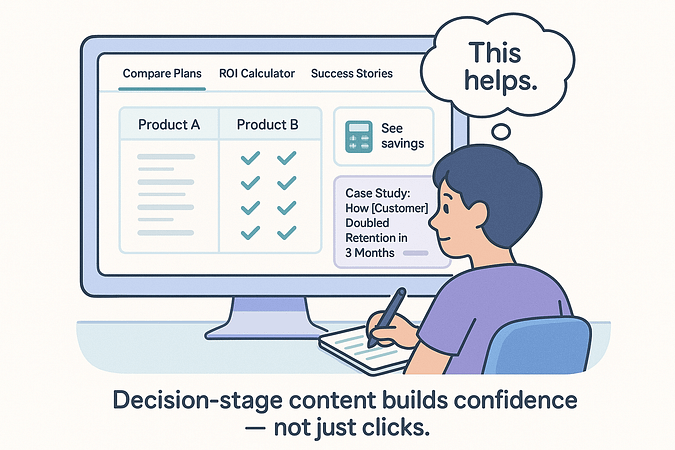
This is the kind of content that supports the final step of the SaaS marketing funnel — the part where a lead is already sold on the category, but not yet sold on you. And if you leave that gap unaddressed? You lose them.
What’s worked best for me is to embed these pages directly into the user journey. Not as standalone SEO plays, but as key links inside onboarding emails, retargeting ads, or decision-stage nurture sequences.
It’s also a major unlock for lead generation for SaaS, especially when paired with behavior-based CTAs — like surfacing a case study about team onboarding only to users on the pricing page.
The more you reduce friction at this stage, the faster the decision feels. And in competitive markets, that speed matters.
So by all means, write helpful blog posts — but don’t forget the content that turns interest into action.
3 Decision-Stage Assets to Build First
If you’re not sure where to start, these are the first pieces of decision-stage content I’d create for any SaaS funnel:
🔁 Competitor Comparison Page
Lay it out clearly: what you offer, what they offer, and who each tool is best for. Skip the takedowns — focus on helping the user make a confident choice.
📊 ROI Calculator or Use-Case Breakdown
Make the value real. Help users quantify what they’ll save or gain by switching to (or sticking with) your product. Time, money, results — pick one and make it visual.
📖 Customer Success Story or Case Study
Highlight someone who started in the same stuck place your reader is in now — and walk through the transformation. Keep it specific. Keep it relatable.
7. Turn Your Emails Into Conversion Funnels
I used to treat email like an update channel. You sign up, you get a welcome series. Maybe a newsletter. Some feature announcements if I remembered.
But over time, I realized I was wasting one of the most powerful tools in the entire SaaS marketing funnel — because email isn’t for checking in. It’s for moving people forward.
The shift happened when I stopped sending based on signup date and started sending based on behavior.
Now, if someone hits a milestone in their trial, doesn’t complete setup, or checks out the pricing page three times without committing — that’s when the right email goes out. Not before. Not after.
This kind of behavior-based messaging does two things:
It gives your users exactly what they need, right when they need it
It saves your support and sales teams from chasing cold leads that just aren’t ready yet
I use Uncanny Automator (and sometimes Zapier) to connect the dots between user behavior and email sequences. It’s not just “day 3 of onboarding” — it’s “this person skipped an essential feature, so let’s send a guide to help them complete it.”
Here are a few sequences that have worked really well for me:
A quick win checklist triggered after someone logs in for the first time
An upgrade path email if they hit a usage limit or start poking around premium features
A re-engagement email if they stall mid-onboarding
A case study or testimonial that matches their use case (based on a quiz or signup segment)
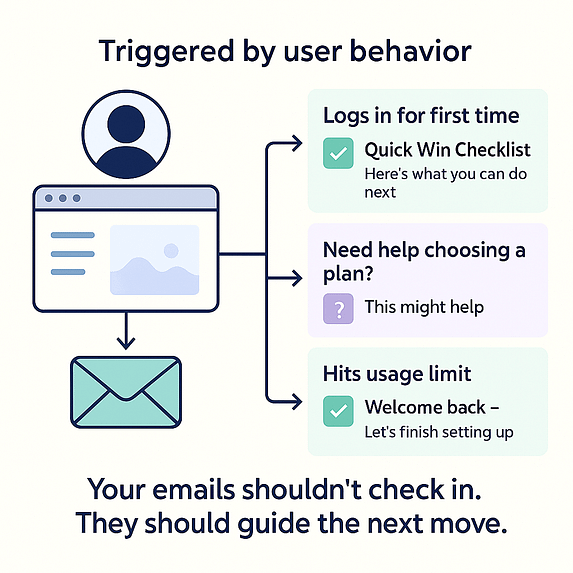
This isn’t about doing more. It’s about doing smarter — and making sure every email earns its place in your subscription marketing engine.
When your emails feel like part of the product experience — not an afterthought — you start turning inboxes into action steps. That’s the difference between “we’ll follow up later” and “they upgraded before the trial even ended.”
8. Go Deep With One Marketing Channel Before Spreading Wide
I get it — the temptation to be everywhere is real.
LinkedIn, YouTube, X, TikTok, email, SEO, paid ads… it’s easy to feel like if you’re not showing up on every platform, you’re missing out. But here’s what I’ve learned: spreading thin too early is one of the fastest ways to burn out and waste budget.
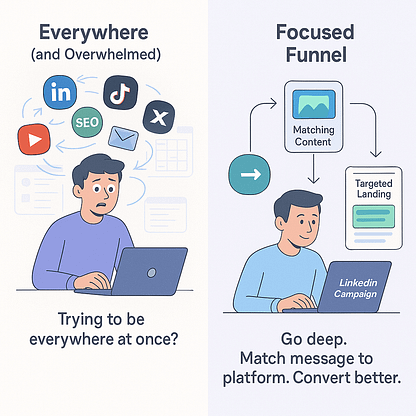
Especially in SaaS, where your message matters and your marketing funnel needs to be cohesive, it’s better to go deep on one channel and make it count.
Here’s what that actually looks like for me:
I pick a core channel based on where my ideal users already hang out — LinkedIn for B2B, YouTube for demos/tutorials, or PPC if I’ve got the targeting dialed in
Then I build content specifically for that audience and that platform
And most importantly, I connect the dots with channel-specific landing pages built in Thrive Architect — pages that match tone, context, and expectations
Because what works on LinkedIn isn’t what works on YouTube. And what converts from a Google ad isn’t going to land for someone who just watched your behind-the-scenes feature tour.
By tailoring the lead generation for SaaS experience to match where the traffic came from, I’ve seen much stronger conversion rates — and more qualified leads who are already in the right mindset.
Once that core channel is profitable and repeatable? Then (and only then) do I start testing new ones.
We actually have an old Thrive podcast on social media do’s and don’ts that is still very relevant today. You can watch it here:
The focus-first approach might feel slower upfront, but it leads to cleaner data, stronger messaging, and a tighter SaaS growth strategy overall.
So no, you don’t need to “be everywhere.” You just need to be really effective in one place first.
9. Personalize Offers Based on Behavior
If there’s one thing that consistently lifts conversions without driving more traffic, it’s this: relevance.
In a good SaaS marketing funnel, it’s not about throwing more CTAs at people — it’s about giving the right offer to the right person at the right time.
That means personalization. Not “Hey, [First Name]!” kind of personalization. I’m talking about real, behavior-based adjustments: what someone has clicked, where they’ve been, what they’ve shown interest in.
Here’s how I use it in practice:
With Thrive Architect, I use conditional display to show different CTAs based on page visits, referral source, or email tags. → If someone’s already in a free trial, they’ll see an upgrade prompt. → If they’re new, they’ll see a “How it works” walkthrough or case study. → If they’ve hovered around the team pricing page more than once, I’ll push a demo request with enterprise-level value props.
With Thrive Quiz Builder, I take it even further — especially when I don’t have deep behavioral data yet. A quick “What’s your best-fit plan?” quiz (basically, a product recommendation quiz) lets me segment users before they sign up, tag them based on their role or goals, and serve personalized follow-up offers via email or dynamic landing page content.
It’s simple segmentation with huge upside. Instead of trying to convince everyone at once, I’m guiding each user toward the offer that actually fits them.
That’s a win for SaaS customer acquisition, a boost for product-led growth, and a massive help for retention — because when someone chooses the right plan from the start, they’re way more likely to stick.
So if your funnel is still one-size-fits-all? This is the place to level up. Use what your users are telling you (directly or indirectly) — and meet them where they already are.
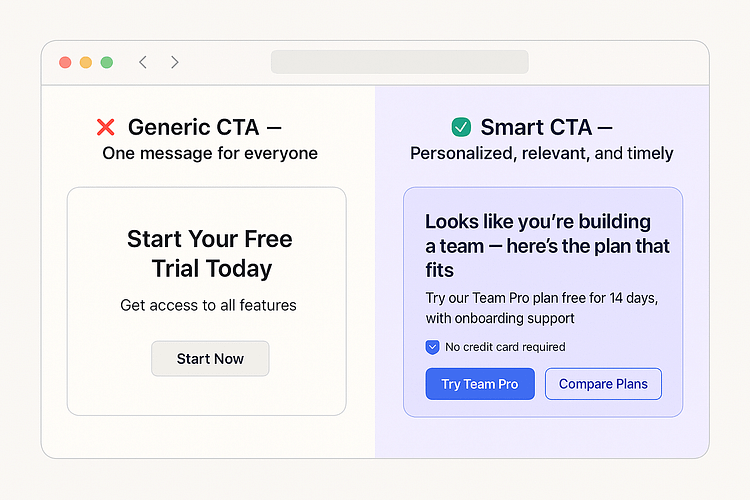
10. Test Creative Campaigns — and Scale What Works
Here’s something no one says enough in SaaS marketing: If it feels a little weird… you might be onto something.
We all love a proven playbook. But at some point, you’ve got to test beyond the basics — especially if you're serious about long-term growth. The channels are more crowded, the messaging is more competitive, and your audience has seen every funnel trick in the book.
The brands that stand out? They try something unexpected — and then double down when it works.
Here’s what that looks like for me:
A “Freemium Friday” promo — only offering free access on Fridays to build urgency
A reverse demo strategy — where trial users send me a walkthrough of how they’d use the product
A surprise quiz in the onboarding flow — to match users with content and support paths based on their goals
A video onboarding challenge with a prize at the end — because gamification works
And none of this would be worth doing if it took a dev sprint and two approvals just to test it.
That’s why I lean on Thrive Suite tools here — I can spin up a new landing page in a day, test a popup variation in hours, or swap a headline without breaking the whole site.
Subscription marketing rewards creativity — especially when it’s paired with speed. The faster you can test, learn, and scale what works, the faster your funnel evolves.
So don’t be afraid to go off-script. Try the campaign you’re not 100% sure will work. Just track it, measure it, and don’t fall in love with anything that isn’t converting.
Because in SaaS, the best growth strategy is a tested one.
Break the Mold: Out-of-the-Box SaaS Marketing Ideas to Experiment With
There’s a time for strategy. And then there’s a time to get weird — in a good way.
These next ideas don’t come from the usual SaaS playbook, and that’s the point. They’re designed to spark curiosity, create urgency, and push your funnel out of the “best practices” rut and into something people actually notice.
They’re also lean enough to test fast, especially if you’re using Thrive tools to build, launch, and iterate without waiting on a dev team.
Ready to shake things up? Try one of these. You might be surprised what clicks.
Pick one and run with it. Then test, learn, and scale what sticks.
Try These: 3 Creative Campaign Prompts for Your SaaS Funnel
Freemium Friday Funnel
What it is: Offer your free trial or freemium plan only on Fridays. The limited access adds urgency, while the weekly cadence gives you a consistent promotion rhythm.
Why it works: It frames your trial as an opportunity — not an always-available fallback. It also gives your audience a deadline, which increases opt-in rates (especially when paired with countdowns and email reminders).
How to build it with Thrive:
- Use Thrive Ultimatum to run a recurring countdown banner or popup that activates every Friday at midnight and shuts off Sunday night
- Create a dedicated “Freemium Friday” landing page with Thrive Architect — lean into the urgency, but keep the message fun and low-pressure
- Use Thrive Leads to capture users on that page, and tag them for a follow-up sequence
Follow-up tip: Send a short “What You Missed” email on Monday to anyone who visited but didn’t convert. → Bonus: use that as your retargeting segment for the next round
Reverse Demo Challenge
What it is: Instead of showing users how your product works, ask them to show how they’d use it — via a screen recording, survey, or even a shared doc. Offer a small incentive or make it a friendly competition.
Why it works: It flips the typical onboarding process, making the user think about real use cases and mentally commit. It also gives you qualitative insight into what they care about most — which you can use to refine messaging, offers, and onboarding flows.
How to build it with Thrive:
- Use Thrive Architect to create a “Reverse Demo” landing page (post-signup or mid-trial) explaining the challenge and instructions
- Add a form with Thrive Leads to collect video links, Looms, or survey answers
- Set up a tag or trigger in your email platform to send a thank-you sequence or bonus reward
Follow-up tip: Use the best submissions (with permission) as onboarding inspiration or UGC. They’re also gold for case studies, testimonials, or sales enablement content.
“What’s Your Use Case?” Quiz Funnel
What it is: A short quiz that helps users identify what features or plan type best match their needs — then routes them into a relevant funnel path.
Why it works: It creates instant clarity for the user (and your team). You’re not just segmenting leads — you’re showing value on their terms. Plus, it converts better than a long form and feels more interactive.
How to build it with Thrive:
- Use Thrive Quiz Builder to ask 3–5 questions around role, goals, team size, or use case
- Route each quiz outcome to a different results page using Thrive Architect (e.g., “You’re a Solo Founder → Here’s Your Lean Setup Plan”)
- Trigger segmented email follow-ups using your email marketing tool — paired with specific CTAs based on the quiz path
Follow-up tip: Offer a small bonus download or checklist based on the quiz result — it adds value while encouraging the next step (trial signup, plan comparison, or onboarding guide).
Frequently Asked Questions About SaaS Marketing
1. What is SaaS marketing, and how is it different from traditional marketing?
SaaS marketing isn’t just about getting people to buy — it’s about getting them to stay. You’re not selling a one-off product; you’re selling a relationship. That means your marketing doesn’t end at the signup — it needs to support onboarding, activation, retention, and upgrades.
It’s also more data-driven, more lifecycle-focused, and way more personal than most traditional campaigns.
2. What are the most important SaaS marketing metrics to track?
Here are the key ones I always keep an eye on — and what they actually mean:
CAC (Customer Acquisition Cost): How much it costs you (in total marketing + sales spend) to acquire one new paying customer. Lower is better — unless you're gaining long-term value.
CLV (Customer Lifetime Value): How much revenue you can expect to earn from a customer over the entire time they stay subscribed. Higher CLV means you can justify a higher CAC.
MRR (Monthly Recurring Revenue): The total predictable revenue you’re bringing in each month from active subscriptions. This is your growth pulse.
Churn Rate: The percentage of users who cancel or stop paying in a given period. Keep this low, or you’ll constantly be refilling a leaky bucket.
Trial-to-Paid Conversion Rate: Of everyone who signs up for a free trial, how many actually become paying users. This tells you how strong your onboarding and upgrade path really are.
📊 Pro tip: Metrics are only useful if they lead to action. If your MRR is flat or churn is creeping up, don’t just watch it — investigate what’s dragging conversions down and optimize that stage of the funnel.
3. How do I improve customer retention in a SaaS business?
Retention starts with onboarding. If new users don’t hit an “aha” moment fast, they disappear.
Start by building a post-signup hub (like a fast-start course or walkthrough), segment your users by intent or role, and use email to re-engage before they go quiet.
Also: collect feedback before someone cancels. A short, well-timed “What’s not working for you?” message can save a customer — and show you what to fix next.
4. What are the best marketing channels for SaaS?
There’s no one-size-fits-all answer, but most SaaS brands see strong results with:
SEO + decision-stage content for long-term traffic
LinkedIn for B2B relationship building
Email marketing for onboarding, upsells, and reactivation
YouTube for demos, tutorials, and evergreen education
PPC (especially search) for high-intent lead capture
That said — don’t spread yourself thin. Pick one channel, go deep, and build a full funnel around it before expanding.
SaaS Marketing That Actually Moves the Needle
I’ve tested a lot of strategies over the years — some that flopped hard, and a few that completely changed how I build and scale. But the biggest shift?
Realizing that good SaaS marketing isn’t about doing more. It’s about doing the right things — in the right order — with the right tools behind you.
You don’t need to be on every platform. You don’t need 12 funnels running at once. And you definitely don’t need to burn out trying to duct-tape your tech stack together just to get a campaign live.
Once I started focusing on conversion-first systems — pages that actually guide users, automations that respond to behavior, onboarding that feels human — everything got easier. Results got clearer. And users stuck around longer.
That’s why I use Thrive Suite, and why I recommend it here. Not as a one-size-fits-all solution, but as the thing that’s helped me actually execute the strategies I’ve shared in this guide — without relying on a dev team or spinning my wheels in setup mode.
So if you’re tired of best-practice fluff and ready to build a funnel that works?
👉 Try Thrive Suite today — and start building SaaS marketing that actually converts.

